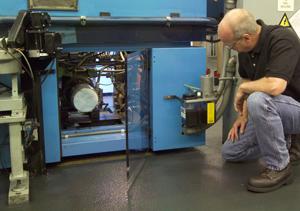Does Your Machinery Suffer From Soft Foot? Here’s How To Check!

Soft foot (otherwise known as machine frame distortion) is a common problem affecting rotating machinery which can have severe – and costly – repercussions.
It can result in a range of mechanical and quality problems including compromised alignment, high vibration levels, accelerated wear and tear, increased power consumption, premature failure of bearings and seals, metal fatigue and distortion. Soft foot isn’t generally regarded as a critical condition and is often overlooked – but the consequences of ignoring the symptoms can be serious.
So how do you check if your machinery is suffering from soft foot?
WHAT IS SOFT FOOT?
As a start, let’s look at what soft foot actually is. In simple terms, it’s akin to a situation where a chair has one leg shorter than the other three, and this unevenness and lack of uniform contact with the floor then causes a rocking motion when someone sits in the chair.
With a machine, soft foot is caused when one or more of the feet are shorter, longer or angled differently to the others or if the feet are damaged, warped or twisted. It can also be caused by dirt or debris which has accumulated under the machine feet, dents in the machine base or excessive tension on the machine feet. When the base bolts are tightened, this non-uniformity puts undue stress on the machine because the foot is forced to bend or twist to conform to the base plate.
DIAGNOSING SOFT FOOT
The condition has different levels of severity but your machine may have soft foot if you notice high vibration levels.
Machine frame distortion (the official term for soft foot) creates a load on the rotating shaft which causes shaft deflection, which in turn can result discernible rocking of the machine or vibration when the shaft turns. However, the condition doesn’t always cause an increase in overall machine vibration so it’s recommended that vibration data is collected in order for accurate diagnosis. If the calculated value of movement of a machine foot when it is either tightened or loosened is at least 0.0508mm (0.002 inches) to 0.0762mm (0.003 inches) whilst the other feet are bolted tightly in place, then the machine is deemed to have soft foot.
When soft foot is present, there is also often a significant 2x alternate current line frequency peak. When this peak is observed, it is a good indicator that the problem is soft foot rather than one of imbalance or misalignment. Phase analysis can also be used to determine soft foot by working out the relative motion between two different parts of the machinery, such as the machine frame and the foundation.
If you want to know whether your machine suffers from soft foot, it’s important to know what causes the condition. Generally, it’s a combination of the following:
- Twisted, bent or warped machinery frames or base plates
- A damaged or uneven foundation
- Too many shims under a foot
- Bent or deformed shim
- Twisted, warped, dented or damaged feet
- Dirt, rubbish etc under the feet
Soft foot can severely affect the operating condition of a machine and therefore it’s essential to include checks for the condition as part of the pre-alignment process for your machinery. If you suspect your machinery may be at risk of the condition, then it’s wise to investigate further using a good laser alignment tool which enables diagnosis of the problem, not just the measurement of it.
Nexxis has a wide range of quality laser alignment tools for sale or for rent which can be used to diagnose soft foot as well as a host of other alignment problems. Contact us to speak to a knowledgeable industry expert about a tailor-made solution which will help your organisation save both time and money.
